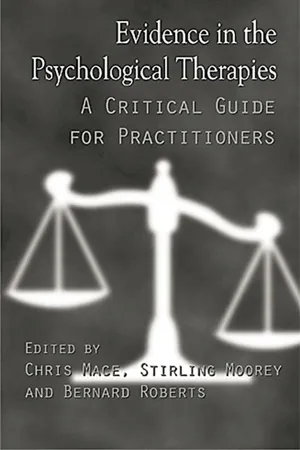Psychology
Psychological Evidence
Psychological evidence refers to the empirical data and findings derived from psychological research and studies. It encompasses a wide range of evidence, including behavioral observations, cognitive assessments, and neuroscientific data, which contribute to our understanding of human behavior, emotions, cognition, and mental processes. This evidence is crucial for developing theories, informing interventions, and advancing the field of psychology.
Written by Perlego with AI-assistance
Related key terms
3 Key excerpts on "Psychological Evidence"
- eBook - ePub
Evidence in the Psychological Therapies
A Critical Guidance for Practitioners
- Chris Mace, Stirling Moorey, Bernard Roberts(Authors)
- 2005(Publication Date)
- Routledge(Publisher)
Chapter 5 Evidence, influence or evaluation? Fact and value in clinical science Paul Sturdee This chapter aims to stimulate debate about the evidential status of scientific research outcomes in mental health. The intention is not to undermine science, but rather to claim that the credibility of science rests on the transparency with which evidential claims are argued. I will argue that scientific research in psychological fields cannot be viewed as providing objective knowledge about phenomena which are themselves unproblematic, and that we should instead view the outcomes of research as being themselves inherently problematic and open to interpretation. The approach taken will be to examine what concept of evidence is appropriate to psychiatry; understanding this will have implications for the closely related fields of clinical psychology and psychotherapy. I will argue that scientific evidence cannot provide proof, it can only affirm our commitment to the conceptual structures and theoretical constructs provided by the paradigm within which what counts as evidence has already been defined. The proponents of scientific psychiatry, especially those who champion evidence-based medicine (EBM) trade, implicitly, on the realisability of an ideal of science as the impartial, disinterested seeking after truth resulting in objective knowledge—although, as I shall try to demonstrate, this realisability is illusory. Science is an inherently social activity with its own ends and means, and those ends and means are circumscribed by the interests and concerns of those who control the signification and dissemination of information and knowledge - eBook - ePub
Understanding the Behavioral Healthcare Crisis
The Promise of Integrated Care and Diagnostic Reform
- Nicholas A. Cummings, William T. O'Donohue(Authors)
- 2012(Publication Date)
- Routledge(Publisher)
What does it mean to incorporate science into practice? I suggest that there are two primary ways of integrating science into psychological and behavioral practice. One is to be as familiar as possible with the empirical literature and strive continually to utilize empirically supported procedures as much as possible. A second is to utilize a scientific approach to the implementation of diagnostic and therapeutic procedures. The former has received considerably more attention than the latter, but the approaches are compatible rather than mutually exclusive. This section first discusses the two approaches one at a time; it ends with a discussion of how they can and should be utilized together.Basing Clinical Care on Scientific EvidenceThe first approach to incorporating science into practice has received more attention. This approach involves ensuring a close tie between clinical care and the latest scientific evidence. For example, if a patient has disorder “A” and well-designed and controlled research shows that treatment “X” works best for disorder “A,” then the patient should be treated with treatment “X” and not any other treatment. This premise that clinical care should be based on scientific evidence may seem simple and obvious. However, defining evidence is difficult, and perspectives vary widely on exactly what constitutes “evidence.”A seminal definition of evidence for psychological treatments was offered in the mid-1990s. A task force of the Society of Clinical Psychology (Division 12, American Psychological Association) published specific criteria for determining whether a given treatment for a given disorder was “well established” or “probably efficacious” (Chambless & Hollon, 1998). In order to be considered “well established,” a treatment must meet one of the following conditions:- At least two good group design studies, conducted by different investigators, demonstrate efficacy in one or more of the following ways: (a) superior to pill or psychological placebo or to another treatment, or (b) equivalent to an already established treatment.
- A large series of single-case design studies demonstrate efficacy. These studies must have (a) used good experimental designs, or (b) compared the intervention to another effective form of treatment.
Key elements in these criteria include replication, careful controls, and experimental design. As in other healthcare fields, careful control and experimental designs are the only ways to establish a causal relationship between a particular treatment and clinical improvements observed as a result of the treatment. Replication is the only way to ensure that results are not due to chance or idiosyncrasies of a particular study. To be sure, the criteria developed by the Society of Clinical Psychology are not the only means of quantifying research evidence. Discussion of varying approaches is beyond the scope of this chapter, but for those interested, other approaches of note can be found in Nathan and Gorman (2002), Roth and Fonagy (2004), and Weisz (2004). - eBook - ePub
- Christine Lister-Ford(Author)
- 2007(Publication Date)
- SAGE Publications Ltd(Publisher)
3
THE EVIDENCE BASE OF PSYCHOTHERAPY
MELANIE EPSTEINThe need for psychotherapists to work within the context of evidence-based practice is becoming a vital part of ethical and professional practice. There has been a growing movement stemming from political, social and economic forces towards collecting and disseminating research results indicating which therapies have been shown to ‘work’. The choice of evidence has profound effects on the way research is interpreted, the directions of future research and on the future direction of psychotherapy practice. There are current trends both to create a scientific paradigm of standardised research criteria and methodologies, as well as attempts to create an integrative or pantheoretical framework of common factors. In what the uninitiated might think of as the dry world of psychotherapy research, there is a great deal of emotion on both sides of the debate. This chapter will explore the evidence base of psychotherapy in connection with this debate. The focus will be on individual therapy, and the evidence base for the humanistic therapies.In the same way as an understanding of a client’s history, social and cultural context is necessary to understand their presentation, build the therapeutic relationship and facilitate their personal journey, so an understanding of the roots of psychotherapy research is important to illuminate the current field. This section of the chapter will review some of the major questions that have been asked in psychotherapy research and the conclusions and narrative that have been derived from these questions.Further information about the history of, and phases in, psychotherapy research can be found in the comprehensive chapters written by Barkham (2002) and Orlinsky and Russell (1994).What is psychotherapy?
The phase of discovery (pre-1950)
Many texts focus on psychotherapy research after the 1950s. That is the time when psychotherapy research evolved in the United Kingdom. However the roots of most current trends existing within psychotherapy research can be seen during the pioneering days of the development of psychotherapy.
Learn about this page
Index pages curate the most relevant extracts from our library of academic textbooks. They’ve been created using an in-house natural language model (NLM), each adding context and meaning to key research topics.


